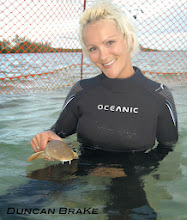There is a popular dive site here in Bimini frequented by not only the Bimini Biological Field Station ( Sharklab) for research and education, but also by local dive and eco tour operators. My first visit to the site was in 2004 while working on a research vessel that was visiting Bimini and I have been there dozens of times since; I am happy to report that it never gets old and you never know what you will see.
The usual stars are Caribbean reef sharks with anywhere from 2 to 20 making an appearance. Like any site frequented regularly, you start to recognize specific animals and I am always happy when old regulars show up.
Although the Bahamas is a shark sanctuary, we have seen people and fishing gear on this site with sharks as their targeted species.
 | |||
| The Bahamas Shark Sanctuary Approximately 243,244 square miles |
 | ||||
| Shark Fishing Gear Left Near Dive Site |
 |
| Caribbean Reef Shark with a Hook Scar on the Mouth |
It had been about a month since Duncan and I visited the site, so with a beautiful day before us we headed out. As soon as we anchored up a single shark finned at the surface. We threw a few pieces of bait in and very quickly we had 4 sharks. We geared up, got the cameras ready and slipped in.
 |
| Happiness! Who Needs Diamonds?! Sharks are a Girl's Best Friend |
The water was crystal clear and the sunlight danced in ripples on the gray skin of the sharks; I absolutely love days like this. We spent over an hour in the water diving down and holding our breath, being as much part of their world as we could for a brief amount of time. The ocean is quiet place and I love lying on the bottom and just watching. I love sharks, if you hadn’t already guessed, but watching them never ceases to amaze me. Lost in the moment, my body reminded me that I am a land animal and must return to the surface.
 | ||
| Duncan Filming Caribbean Reef Sharks |
 |
| Freediving Shark Selfie |
Throughout the Bahamas Caribbean sharks dives and snorkels draw divers, film crews and shark aficionados from around the world. These sharks are also responsible for educating thousands of people and changing fear into fascination and respect. Five minutes is all it takes to create a new perception and shark eco-tourism throughout the Bahamas has not only been good for the economy, but good for the sharks that swim around these islands.
We ended our dive and got back on the boat. I threw in some of the last scraps of bait and chatted with the sharks, as I always do. Duncan giggled, like he always does, amused by running commentary. I absolutely love being around these remarkable creatures.
 |
| Shark Geeks! Loving The Gorgeous Day! |
I am a huge proponent of getting in the water and having your own shark experience, so if you find yourself in the Bahamas or somewhere offering a shark encounter, I encourage you to dive in! If you are in Bimini check out the Sharklab's Research Experience , Bimini Sands for shark snorkels or the Bimini Scuba Center for scuba diving trips.























